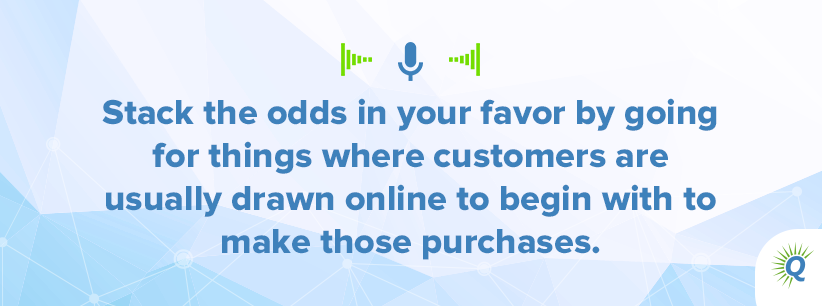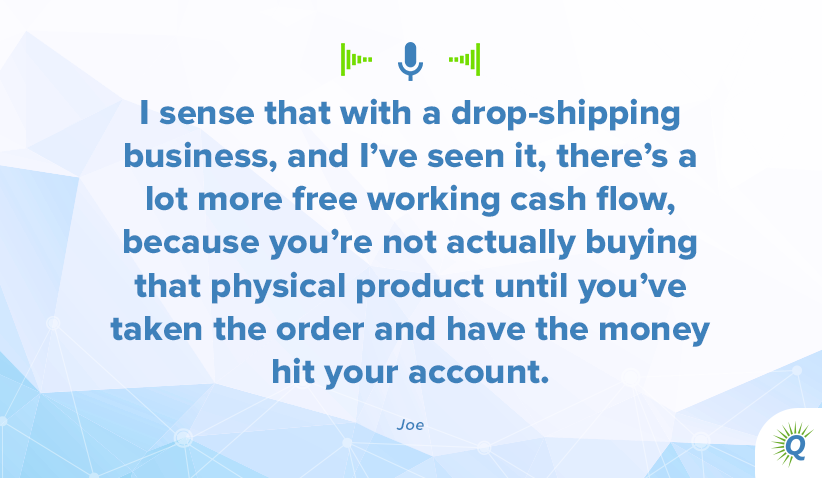Topics:
Never Miss a Beat - Get Updates Direct to Your Inbox
FILTER:


A Business Model That Helps You Zig While the Rest Zags
By Quiet Light
If you are looking to start or buy an ecommerce businesses for sale, optimizing order fulfillment will help you in a number of ways. Many entrepreneurs believe FBA is a great way to go, but Anton Kraly from Drop Ship Lifestyle believes that drop shipping is still a great method of fulfilling orders. In this post, we discuss the benefits and drawbacks of drop shipping:
Strengths and Weaknesses of Drop Shipping
The Biggest Disadvantage to This Model
What Products to Sell and How to Find Them
Once You’ve Chosen Your Niche, Then What?
How Do You Convince Brands to Let You Sell For Them?
Besides Google Ads, what channels work?
The Brand Model Versus the Drop Shipping Model
One of my favorite comments on the podcast so far occurred last week when Joe remarked about Amazon, “They can’t have everything, right?”
As entrepreneurs, I think most of us would really like to answer yes to that question right now.
Though the list of things that Bezos and Amazon already take an interest in (monetary and otherwise) keeps getting longer.
That list now includes and is by no means limited to:
- Retail
- The cloud
- Streaming services
- Publishing
- Ford automobiles
- Real estate
- Uber
- Indoor drones
- Health care
- Robotic clothing
- Gravity
Oh, and time.
Not the publication, but the fourth dimension of reality. So, yeah.
It’s fair to say it’s a forward-thinking enterprise that seeks to get out ahead of us.


Listen to the Source of this Post:
This blog post is based on a podcast episode that we recently recorded. Listen to the full episode here:Then there’s the list of skills which Amazon has utterly mastered on its marketplace when it comes to ecommerce:
- Creating a visibility platform for products while streamlining operations for those who sell them.
- Collecting and using real-time customer data.
- Creating a closed system for vendors that handles all things including lending and advertising.
- Attracting high-converting customers and keeping them.
Also good at:
The fairness of Amazon’s tax benefits and certain loopholes may spark debate into eternity, but one fact that’s not debatable…in online retail, Amazon’s dominance continues to grow.
Of all ecommerce businesses for sale right now, a huge percentage of them make most if not all their sales there.
In 2018, the company single-handedly controlled 49% of the US ecommerce market.
That still leaves roughly $258 billion for those of us not selling on the platform.


Meanwhile, drop-shipping expert Anton Kraly has made it his business to go where Amazon doesn’t seem to be going in online retail. Yet.
Kraly built his first ecommerce store in 2007 after reading Tim Ferriss’s The 4-Hour Workweek.
Like so many others at the time, he found in Ferriss an introduction to the wonders of Yahoo Stores and Google Adwords.
But Anton didn’t just read the book, he put it into practice. Immediately.
In just one week, thanks in part to his day job operating a delivery route for a Brooklyn bakery, he figured out how to make ecommerce work selling cookies and never looked back.
Soon he would expand to new markets, become a successful importer bringing goods from China to Longbeach, California, and then finally circle back around to the drop-shipping model he inadvertently started out with.
It’s that model he uses and teaches today, and one that when you’re looking at ecommerce businesses for sale, you may find reason to consider.


Through his company, Drop Ship Lifestyle, Anton helps entrepreneurs first build online retail stores around products that aren’t highly competitive or common on the Amazon marketplace at the moment.
And second, become very good at those things that aren’t yet at the top of Amazon’s skills list, mostly due to the immensity of the platform.
Things like:
- Being personable and human in dealing with customers, and making them feel cared for.
- Creating community and engaging content around products and multiple income streams.
Embrace Uncertainty and Act
Yes, drop shipping’s boom years seem behind us, and considering the rush to sell on Amazon, you might question whether or not it’s still viable.
But any successful investor will tell you, if you want to make money, you must bet against the crowd.
One thing I really like about Anton is the way he embraces uncertainty when asked about the risk Amazon’s dominance poses to the drop-shipping model right now.
He doesn’t know exactly what’s coming in the long term, and he’s not afraid to admit it.
He’s not oblivious to the risk and says he doesn’t expect Amazon to suddenly back down from its big goal of world dominance. But he’s constantly pivoting and figuring out what works anyway.


That seems to me one of the secrets to success that so many entrepreneurs interviewed on the Quiet Light podcast have figured out…in the face of risk, they admit they don’t know.
And then act anyway.
Ed Catmull, former President of Pixar Animation and Disney Animation says in his book Creativity Inc, “I believe the best managers acknowledge and make room for what they do not know – not just because humility is a virtue, but because until one adopts that mindset, the most striking breakthroughs cannot occur.”
In other words, within great uncertainty lies the potential for great success.
Anton Kraly’s had plenty of breakthrough successes in ecommerce already, and he remains willing to zig when others zag.
Let’s look at Anton’s model for doing just that, define his version of drop shipping, and see how selling other people’s brands realistically stacks up against creating your own.
The Drop Ship Lifestyle Model
So what is drop shipping exactly?
Anton points out that the term actually encompasses a multitude of different business models.
When you look at the array of ecommerce businesses for sale, you’ll find one or two variations on the theme.
The internet retail model that he uses and teaches, he says, operates a lot like many brick-and-mortar retailers, such as
Dick’s Sporting Goods, found all over the US.
Anton’s version of drop shipping simply means selling other people’s products online. And it looks like this:
- He finds the top 50 companies in the US selling a product like sofas or bookshelves. (more on which products he recommends and why later)
- He reaches out to them to secure the right to sell their products on his sites.
- The brands provide their full catalog including item descriptions, SKUs, and images required for him to list the products.
- He provides another sales platform for the brands by creating content around and otherwise making their products appealing online.
- He drives customers to the site in the form of traffic and converts traffic into sales.
- He provides great customer service so those customers who purchase the brand’s products are well cared for.
Much like Amazon, his job is to create a visibility platform for other brands in carefully chosen niches but with perhaps a more personal, more engaging touch.


The beauty of the model, he explains, comes from the fact that he never has to purchase the product himself, ship it to his own warehouse, or pay to store it. Zero logistics.
Instead, when a customer makes a purchase at his online retail stores, after the sale is made, the order gets forwarded to the brand. And the brand then ships the product directly to the customer.
Strengths and Weaknesses of Drop Shipping
The main strength of this model comes from the fact that it doesn’t gobble up working capital.
Assuming you use credit, you can potentially get paid for a sale before you shell out any cash for it.
For the product itself, that is. Advertising will be another matter. (More on that below)
That’s a powerful strength to consider, because in most product-based business models your ability to grow depends entirely on your access to working capital.
Often those ecommerce businesses you see listed for sale have come to that point where the original owner can’t go any further without cash.
Not so with drop shipping. The limits here are tied to your ability to drive traffic rather than to access cash.


Another major strength?
Your ability to get started with little help or capital.
Anton says that with his model, if you’re willing to do all the work yourself in the beginning, you only need about $1-2K to get off the ground.
If you opt to outsource the initial work of setting up your store, on the other hand, that figure edges up closer to $10k.
He doesn’t recommend outsourcing paid ads in the early days. I’m guessing that’s due to the need to wait, prove your niche, and maybe refine your systems before you begin to scale.
“It’s easy to throw money away,” he cautions.


The Biggest Disadvantage to This Model
In a word – margins.
When you private label products and create your own brand, you simply capture more profit margin.
As Anton puts it, “you’re not paying for someone else’s brand equity.”
Of course, there’s more to profitability in ecommerce than gross margins, but it represents one of many important considerations when you look at this model.
Anton recommends with drop shipping that once you have a profitable retail store and the cash flow that comes with it, plus lots of data about which products sell the best and at the highest profit, you introduce your own brand to the mix and maximize margins that way.
It’s another thing to love about this model – you can ship now, so to speak, and iterate later.


What Products to Sell and How to Find Them
Anton has developed simple guidelines for choosing a product niche around which to build your online store:
- Go with products that have a higher sale price than those in Amazon’s sweet spot – target products in the $1000 or higher range.
- Look for products where brand loyalty is not the driving factor for a purchase. For a buyer, lighting fixture and bookshelves, for instance, must meet the right criteria for a space. For these products, the right color and style, but not the brand, matter most.
- Speaking of color, choose products with many possible variations from the manufacturer. Again, buyers should be searching for the right fit and the exact match for their needs, not the specific brand or the lowest price.
Anton recommends that you think about products that fit along those lines and around which you can build an engaging content site.
Industries like gaming, productivity, recreational boating, and cannabis growing, for instance, fit that bill plus allow you to create a sense of excitement and community around your products.
Not to mention multiple revenue streams.


Once You’ve Chosen Your Niche, Then What?
To find suppliers, Anton advises, use Google. But don’t go searching for “drop ship suppliers.”
That type of search will result in nothing but expensive middle men, and you’re much better off connecting with brands directly.
What terminology to avoid in search results, according to Anton?
- Distributors
- “Drop ship suppliers”
Instead, look for manufacturers, brands or suppliers of the exact products.
For instance, “gaming chair suppliers” or “popcorn machine manufacturers.”


How do you convince brands to let you sell for them?
This is the next step. To be convincing, Anton says, be professional and prepared.
Before you approach brands, have these areas in place:
- A great looking website with high quality stock images as placeholders.
- About us page and blog posts.
- Working phone number and live chat.
- A list of their top competitors that you’ll also sell on your site.
- A plan for delivering great customer service.
- A strategy for getting traffic and running a successful store.
In terms of the right platform, Anton recommends Shopify, he says, “for 99% of stores.”
Once you have the store set up and the products and brands to sell, it’s time to find your customers.


How to Find Your Customers and Which Marketing Channels Work
For this step, Anton keeps it relatively simple. He targets shoppers searching on Google for the specific products using:
- Google Shopping
- Google product listing ads
Google, he says, and the product ads he’s able to place there have always been his highest converting source of traffic.
He stresses that everything you’ve done up to this point to set up a store and an online retail business is important, but, “if you’re not really active inside your Google Ads account, then it doesn’t matter.”
He recommends a continuous process of optimizing ads to target the right buyers, keep CPA down, and maintain an acceptable ROI on ad spend.


In this business, expect to allocate the biggest portion of your budget to marketing.
The good news when it comes to Google Ads? Anton explains that buyers responding to his targeted ads sit pretty close to the bottom of the funnel, ready to buy.
“Typically, by the time they click one of our ads,” he says, “they’ll buy within 3-5 days.”
That means you’ll know what’s working (and what’s not) relatively quickly, which minimizes the amount of money spent testing ads.
Besides Google Ads, what channels work?
Anton also recommends other marketing tactics. Those he’s seen the best results from include:
- SEO on product pages, especially the top 20% sellers.
- Bing, which works only with a small budget in his experience (around 10% of his overall marketing budget.)
- Facebook ads for retargeting only.
- YouTube ads for retargeting website visitors as well.
- Influencer marketing using banner ads and sponsored content on related content sites.


The Brand Model Versus the Drop Shipping Model
To summarize the difference between these two models, I’d say that branding your own products comes with a lot more up-front costs and requires more working capital to scale.
With the brand model, you’ll spend before revenue on:
- Website (unless you use Amazon only)
- Product and packaging
- Branding
- Shipping to you or your warehouse
- Storage in some cases (such as FBA fees)
- Marketing and paid traffic
While the drop shipping up-front costs include:
- Website
- Marketing and paid traffic
It’s a streamlined model, no doubt, with the possibility of a lower start-up cost. And as Joe pointed out on the podcast, the private label and FBA models often require owners to put virtually all profits back into the business to maintain momentum and keep up with growth.
Still keep in mind that a private-label business may command a higher multiple at sale, so the pay-off comes later.
Among ecommerce businesses for sale, those with a strong brand and loyal customers will definitely carry weight with buyers.
By contrast, with the drop shipping model, you should have more discretionary cash freely available while still growing revenues. The pay off can come sooner and more consistently in that case.
And make no mistake, profitable growing drop-ship businesses are still highly attractive to buyers.


If you’re starting an Amazon FBA business right now, you have platform risk to consider, as changes on the marketplace are common, and cut-throat competition seems ever-present.
Likewise, if you’re starting a drop-shipping business, the future will never be 100% clear.
Welcome to ecommerce, where uncertainty is a given.
In his book Uncertainty, Jonathan Fields explains that fear and doubt about the future can actually act as fuel as long as they’re handled well.
It seems to me that through its prescription for action, for creating retail stores, finding and serving customers, and iterating as time goes on, Anton’s model does just that.
And does it creatively.
“Anything certain has already been done,” Fields writes. Too late for that.
Later he quotes Viktor Frankl in Man’s Search for Meaning:
…between stimulus and response, there is a space. In that space is our power to choose our response. In our response lies our growth and our freedom.
If Amazon’s quest for ecommerce domination is the stimulus, Anton has chosen a response, and you get the feeling he’ll keep responding.
Amazon may be well on the way to achieving its big goal, but like Joe says, they can’t have everything. Not yet.
There’s still that space for entrepreneurs to create and grow viable businesses right now.
There’s still that space for us to respond and act. And in the face of uncertainty, that response is everything.





